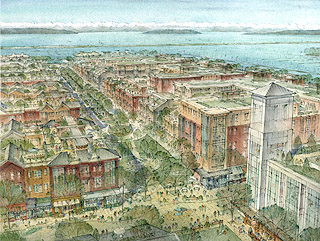
DJC.COM
September 25, 2008
Put mixed uses where they belong — by the water
GGLO

Panton
|
Smart, low-impact urban development in the Puget Sound requires balancing what can appear to be competing interests — the inevitable growth of our region and the preservation of the ecology of our fragile shorelines.
However, these interests, as championed by our state’s Growth Management Act and the Shoreline Management Act, respectively, can be brought into alignment by enhancing existing SMA policy to encourage mixed-use projects.
Such projects are a cornerstone of successful urban development and have the potential to meet the goals of the SMA and the state Shoreline Master Program Guidelines, which are to encourage water-dependent uses, promote public access and protect the shoreline’s natural resources.
By 2040, the Puget Sound region is expected to add another 1.7 million inhabitants. With many cities and municipalities (and their urban growth boundaries) fronting our waterways, other forms of development beyond water-dependent uses on our state’s shorelines are inevitable. What follows is a discussion of how mixed-use projects can achieve the necessary balance that this intersection of growth and ecology requires.
Waterfront uses

Image courtesy of the Port of Everett Everett’s Port Gardner Wharf will have a 1.5-mile esplanade to improve access to the waterfront. The 65-acre development will also include more than 18 acres of open space. |
Presently the SMA provides support and preference for uses that are “water dependent,” such as maritime/commercial and maritime/industrial.
It makes sense that these functions are encouraged on our shorelines, as they provide quality employment opportunities, which in turn contribute to economic vitality and strong communities. In Washington state, one in three jobs is tied to the import and export of goods that come through our ports. Maritime uses are also an important part of region’s heritage and unique character, contributing to our sense of place.
Can maritime uses be balanced with the need to inject more residential density along our urban shorelines?
The Thea Foss Waterway in downtown Tacoma is an excellent example of waterfront development that integrates residential mixed-use development with adjacent maritime industrial. When full development is complete, the Foss Waterway also will include a public esplanade, parks, office and retail. The city of Tacoma’s leadership and Port of Tacoma’s commitment to being good neighbors have led to the successful integration of uses on this project.
“I imagine the scope of our 24-hour operations, particularly the noise and lights, could be unsettling to some residents at Thea Foss and surrounding neighborhoods,” said Evette Mason, community relations manager with the Port of Tacoma.
“We’ve partnered with other area businesses and taken an active approach to mitigate those impacts as well as how to best interface with nearby residents and future Thea Foss neighbors by planning a light- to medium-industrial buffer zone between our businesses and the Foss Waterway.”
Public access
Compact, mixed-use projects can facilitate and expand public access, and are therefore very much in alignment with SMA policy. A great example of this is Port Gardner Wharf, a 65-acre mixed-use community in Everett that includes over 18 acres of public open space.
Port Gardner Wharf has beautiful views overlooking the bay, islands and the Olympic Mountains. In doing the master planning for the site, GGLO was tasked with maximizing these views for the commercial and residential communities, while making the site inviting to pedestrians and promoting public access to the waterfront.
“We were able to reconnect the public to the waterfront by designing a 1.5-mile-long esplanade and a rich and varied network of parks, roadways, and pathways that integrate with it,” says Alan Grainger, a principal at GGLO.
“Weaving public access into the development has allowed for the fostering of a diverse community that can enjoy the waterfront.”
Revising guidelines
For those proposing compact, mixed-use projects within shoreline jurisdiction, the water-dependent use provisions of the SMA can prove to be the most challenging to satisfy.
The lack of inclusion of mixed-use projects as a priority or “preference” in the SMA can provide a potential path for opposition groups to object and appeal, which can add years to a project’s entitlement process. The Shoreline Master Program Guidelines should be revised to support mixed-use projects that also meet the SMA goals of encouraging water-dependent uses, promoting public access and protecting shorelines’ natural resources.
“Additional flexibility and creative license need to be granted to our local governments to harmoniously integrate pedestrian-oriented, mixed-use development with traditional water-dependent uses,” said Dennis Derrickson, a senior planner with David Evans and Associates.
“The implementing guidelines for both the Shoreline Management Act and the Growth Management Act should be amended in a coordinated manner to more proactively assist cities of all sizes in their efforts to facilitate innovative mixed-use redevelopment projects.”
Future development
The SMA and the GMA are both successful public policies whose impacts on future development possibilities are still unfolding.
As municipalities shape their shoreline master programs, consideration should be given to encourage dense and compact mixed-use development alongside water-dependent uses. Likewise, ports and private waterfront development groups are wise to consider the potential of mixed-use projects in their plans as our leading cities meet the demands and challenges of forward-thinking urban development.
Ted Panton is an associate at GGLO, where he leads integrated design teams through projects such as the master plan for Port Gardner Wharf and Shorewood Heights on Mercer Island.
Other Stories:
- 5 principles for renewing Seattle’s waterfront
- Group efforts make for better shorelines
- Seattle’s waterfront a showcase of lost opportunities
- Competing goals drive Anacortes marina project
- Redevelopment: fraught with challenges, but worth the plunge
- Great civic developments need private know-how
Copyright ©2009 Seattle Daily Journal and DJC.COM.
Comments? Questions? Contact us.